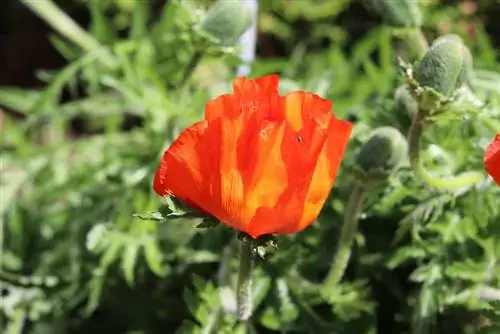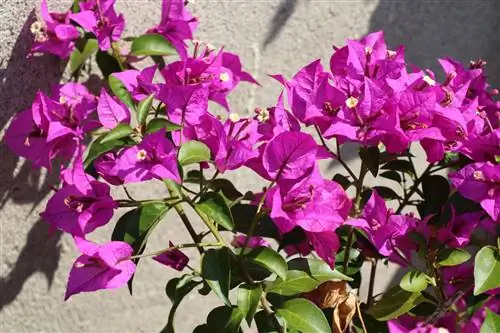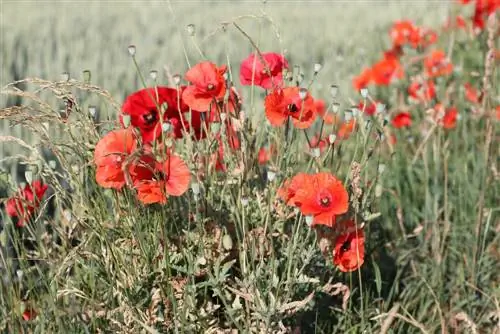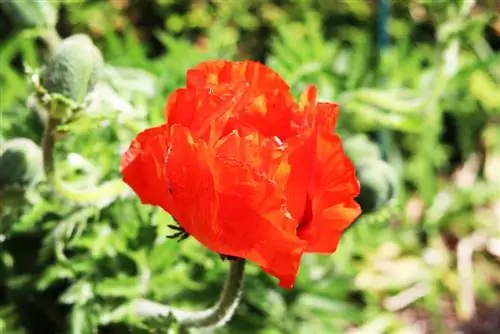- Author admin [email protected].
- Public 2023-12-17 03:39.
- Last modified 2025-01-24 12:45.
Poppies are a welcome guest in the garden because of their striking flowers. The Turkish poppy, also known as the Oriental poppy, comes in various shades ranging from red to yellow to white. Like many other poppy varieties, Papaver orientale is hardy and can withstand even extremely cold winters if the plant has been properly cared for over the past year.
Is the Turkish poppy hardy?
The Turkish poppy, Papaver orientale, is a species of the poppy family that comes from the western part of Western Asia. As the name suggests, it comes from Turkey and is also native to Iran and the Caucasus. Due to its natural distribution at the foot of mountains, it is necessary for the plant to withstand cool temperatures and snow. The fire poppy thrives over the summer due to numerous hours of sunshine, which enable the plant to grow robustly.
If the Turkish poppy's growth is not disturbed, it can be brought through the winter without any problems if certain requirements have been met. Newly planted poppy plants can also survive the winter without any problems if the seeds were planted in the ground at the right time. Turkish poppy has a hardiness level in climate zones 3 to 8a, which makes the plant a long-lasting plant even in colder regions.
Turkish poppies in winter
Papaver orientale is, compared to other poppy species such as the local corn poppy, a perennial that is particularly long-lived and for this reason can be found in many perennial beds. Like other perennials, the upper part of the poppy, i.e. the leaves, flowers and shoots, dies almost completely and only the roots with the taproot and some of the greenery remain, which will sprout the following spring. This bit of green remains throughout the winter and from year to year the plant grows wider, which illustrates the growth of the perennial.
Tip:
Each color variant of Papaver orientale behaves the same over the winter. Therefore, you don't have to worry if your Turkish poppy with white or salmon-colored flowers loses all of its greenery, because it will return in spring and, with proper care, become the true splendor that poppies are known for.
Winter preparations
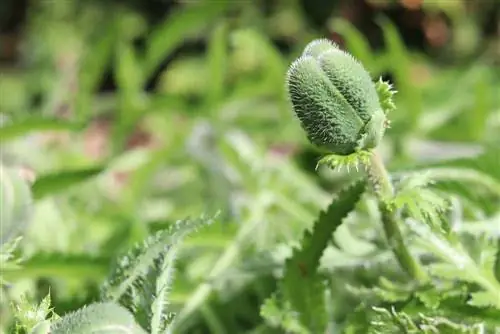
In order to get the garden poppies through the winter, preparation in autumn and care in summer and spring are crucial. These enable the poppy to grow strongly, which helps the plant survive in the winter. Since it can withstand temperatures of up to -40°C and loses all of its greenery during the winter, the root in particular needs to be prepared. The most important point is the location you have chosen for your poppies. This must generally have good drainage, otherwise the roots will rot, as Turkish poppies cannot tolerate waterlogging at all and can die very quickly. Therefore, you should choose permeable soil for your poppies so that they are not drowned by the first thaw in spring. In addition to the location, you should take care of the following points:
- Withered flowers
- Plant supports
- Remove green
- Set up winter protection
Tip:
If you have a particularly old specimen that has already had several winters, you can completely forego winter protection. Oriental poppy is so robust that it no longer needs any protection as it gets older, but it should be protected for the first few years.
Withered flowers
Unlike other plants, the Turkish poppy does not need to be removed from withered flowers. Since the poppy is treated with pruning in between, especially in early summer, no pruning is necessary before the onset of winter. Even if the poppy still has remaining flowers that have withered over time, you can simply leave them on the plant. Pruning at this time could damage the important greenery needed for spring sprouting. Because it is rare for poppy flowers to remain present until the end of fall, many gardeners are confused about whether they should cut them off. However, due to the behavior of the poppy, this is really not necessary.
Tip:
Listen carefully if you find dried flowers on your Turkish poppy. Since the flowers have withered, the characteristic clacking of the dried seeds can be heard, which are still in bloom.
Plant supports
The older the Turkish poppy gets, the higher it grows over the year. Despite its robustness, it can easily be bent over by strong winds, people and animals. For this reason, the plant always needs supports to prevent it from breaking. Since the poppy completely retreats over the winter, you can remove the supports and only put them back in the bed in spring when the oriental poppies appear again. This is particularly recommended for supports that could rot or rust due to moisture in winter. In this way, you can also give the poppy a growth direction the following year, according to which it can orientate itself.
Remove green
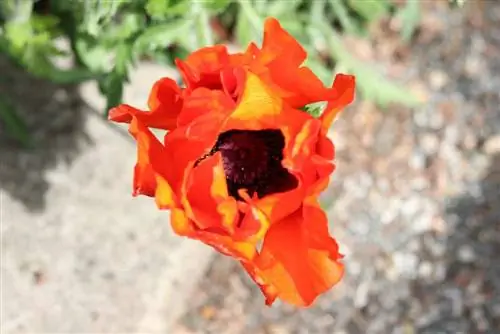
Before you can set up the important winter protection, you have to remove the previous greenery that the poppy has shed. To do this, simply run your hand over the shoots of the poppy and any that have already dried out will fall off very easily. Then collect all the greenery that is on the ground so that the earth is free for winter protection.
Set up winter protection
Despite their insensitivity to cold, it is advisable to provide winter protection for the Turkish poppies. The best time for this is mid-autumn, as from this point onwards more and more green dries up and recedes. A small layer of various materials that can be used as mulch is sufficient for the plant. Mulch made from the following materials is best suited for this:
- brushwood
- Straw
- Leaves
Mulching helps the plant stay warm in winter, which is especially recommended for young plants in the first year, and to provide the poppy with nutrients. Since the fire poppy is rarely fertilized, mulching is a particularly good option for winter protection, as the nutrients can be easily absorbed by the roots. They support the roots in their function of getting the plant through the winter. The plant materials listed above work very well as mulch because they rot easily, but not too quickly. This means they can be used effectively for the cold season without being too heavy on the roots. The mulch is distributed as follows:
- Prepare the mulch. This means, for example, that you take a large pile of leaves that have accumulated over the fall and move them close to your poppy plants. This shouldn't have already rotted as this happens over the winter.
- After you have cleared the Turkish poppy's location of any remaining greenery, spread the mulch around the plant in a layer. This should be tight, but does not have to be high. It should have no open spaces and act like a blanket so that the roots remain insulated.
- Insulate the root area particularly well, as this part of the plant is the most sensitive. All you have to do is take a little more mulch and dress the part of the plant that sticks out of the ground particularly well.
- Now you can simply leave the plant over the winter and continue to look after it in the winter.
Winter hardiness in young plants
Turkish poppy is an easy-care plant that can be grown very well in the garden and overwinters without any problems, even in the first year. Although they are not as frost-hardy as older specimens, for example because their taproot is not yet as developed, they can survive in the garden without any concerns. You don't even have to use your bag of tricks, just follow the points mentioned above and use a little more winter protection for the young roots.
Propagation during winter
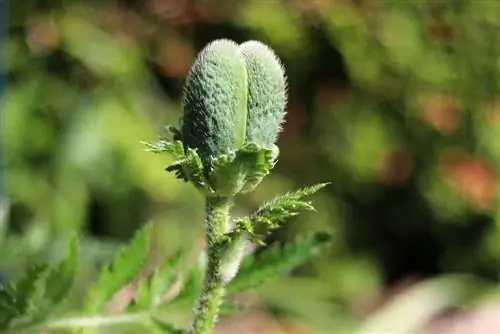
If the poppy gets too big, many gardeners tend to propagate the plant, which is a really easy thing to do with the Turkish poppy. It is even possible to propagate the plant during the winter period, taking into account certain points so that the plant does not suffer from division. Since the Turkish poppy is very robust and forms a large number of roots next to the actual taproot, these are easy to reach and can be removed without damaging the plant.
The root cuttings do not reduce the winter hardiness of the plant and are a good way to provide new specimens without having to sow seeds. The advantage of dividing over the winter is that you don't have to wait for seeds to form or do a large-scale division that can't be done until spring. You can obtain root cuttings as follows:
- Look carefully at the roots of the plant and select one or two fairly young roots. Never cut the taproot, otherwise the entire plant will suffer.
- Take a sharp, clean knife and cut the cutting. You should be careful not to crush the roots and for this reason you should not use scissors.
- If there are any growths, remove them.
- Place the cutting in a pot with substrate suitable for poppies and keep the plant indoors until spring.
- After shoots have formed, the poppy can be planted in the garden at the beginning of spring. Make sure to plant the plant in the same soil, as the Turkish poppy does not tolerate being transplanted very well.
Overwintering in a pot
If you grow young plants in pots and have placed them in the garden too late, it is recommended to grow them in the apartment or winter garden. Young poppy plants should always be planted in spring in order to bind themselves to the site with the roots and if this is not done, the plant must remain in the pot until the next spring.
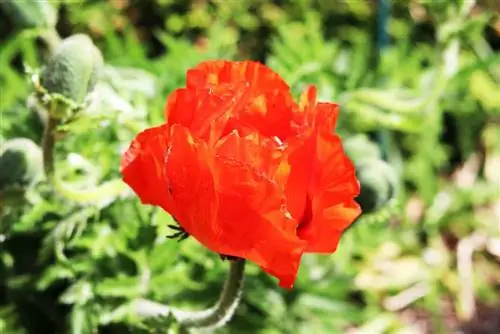
If you spend the winter in the pot, make sure not to store the poppy too warm so that it can rest. Do not overwater it and do not use fertilizer, as the taproot would not be able to withstand it. Choose a spacious pot for the poppy so that the plant does not lack space. Pots that are taller are well suited for this. Ideally, you should use a compostable pot that you can place with the plant from spring onwards.
After winter
As soon as winter is over and spring appears, the winter protection from the previous year should definitely be removed. Since it can become saturated with water due to the warm temperatures if it is not completely rotted, it becomes a danger to the poppies. This is very sensitive to too much moisture. After removing winter protection, you can continue with spring care as usual.
Tip:
You can use fresh compost as frost protection if you are worried about late frosts. To do this, simply spread a small amount of compost where you previously removed the winter protection.

